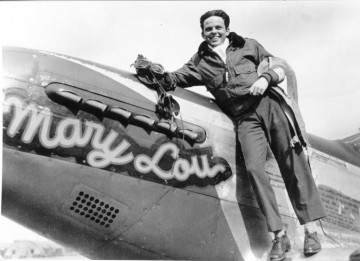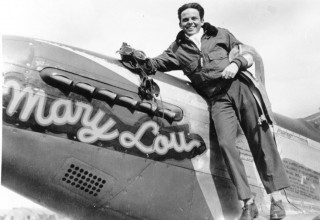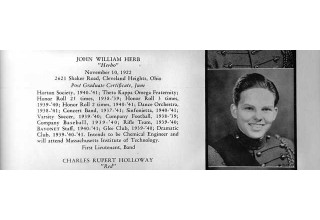Riverside Ring Solves 70 Year Mystery
Second Lieutenant John W. Herb, WW II fighter pilot and a 1940 graduate of Riverside Military Academy, will be laid to his final rest next month after almost 70 years.

Gainesville, Georgia, June 8, 2015 (Newswire.com) - Second Lieutenant John W. Herb, WW II fighter pilot and a 1940 graduate of Riverside Military Academy, will be laid to his final rest next month after almost 70 years.
The recovery and repatriation of his remains involve a German man, who as a boy watched a P-51D, flying low, clip a tree and crash in April 1945. The second significant clue was a silver ring with a blue stone that glittered in the sandy soil. A man and a ring led to the positive identification last summer of the remains of the 22-year-old pilot.
Herb, of the 359th Fighter Group, 368th Fighter Squadron, will be interred at Arlington National Cemetery on June 18 with full military honors.
Like so many of the greatest generation, John William Herb of Cleveland Heights, Ohio, seemed destined to achieve anything he wanted. He entered Riverside Military Academy in Gainesville, Georgia, in 1937 as a sophomore. For three years he excelled at everything the Academy offered – academics, the dance band and orchestra, drama, soccer, football, and rifle team. He graduated in 1940, but stayed on for a post-graduate year, a common decision for parents as war in Europe seemed imminent. Parents saw the military academy’s preparation as an advantage for young men perhaps headed to war. Riverside, founded in 1907, was and is an all-male preeminent military academy, and during the height of the war commissioned the post-graduates as lieutenants after receiving their diplomas.
Herb’s post graduate yearbook photo depicts a bright-eyed smiling young man with a nickname of “Herbo.” Beneath the list of his accomplishments it states his intentions to attend Massachusetts Institute of Technology and study chemical engineering.
Herb did just that, but he cut his studies short when he enlisted in November, 1942.
He served in the European Theatre of Operation (ETO) beginning in January, 1945 with the 368th Fighter Squadron out of Station F133, East Wretham, England. His P51-D was painted with the name “Mary Lou.” They went down together just three months later.
On April 13 on Mission 343 to attack the marshaling yards at Neumunster, Germany, his unit strafed ground targets resulting in 15 enemy aircraft destroyed and seven locomotives. While making an attack on ground aircraft south of Neumunster, Herb flew too close to trees and tore his coolant scoop off. Unable to gain altitude, he continued flying in an attempt to crash land, but instead the P51-D crashed into trees and fell burning to the ground northwest of Hamburg. No airman observed him exiting the plane, and Herb was presumed KIA.
In 1950 the U.S. Army Graves Registration Command conducted an investigation of the presumed crash site, but Herb’s wingman steered the Command to another site in Russian-controlled territory. Unsuccessful, the War Department declared John W. Herb’s remains to be un-recoverable, and the family was notified of the same.
But, a five-year-old German boy, Manfred Romer, who watched the burning plane fly directly over him before crashing into the woods, never forgot that vivid scene. Following clues of village lore he began asking questions and learned of a grave, which had been cared for by a female forestry worker. He eventually found witnesses of the crash, who maintained Herb survived the crash, but was shot by persons in uniform and buried nearby. Using a metal detector, Romer continued his investigation and found parts of the wrecked airplane. At this point, he contacted German officials, which led to the notification of the American Joint POW/MIA Accounting Command (JPAC) investigation team.
In June 2014, Romer, now 74, led the team to the crash site, and Herb’s remains were found in a nearby shallow grave just 40 centimeters deep in the sandy soil.
“The scene and mood of the team were serious and somber as the excavation continued,” wrote SFC Nicholas Deeb, a member of the team, in an email to RMA president, Dr. Jim Benson. “While conducting dry screening of the surrounding dirt, the team found what, at first glance, seemed to be metal parachute material.”
The metal was not Air Force issued equipment, but Herb’s Riverside class ring with the year 1940 on one side of the blue stone and the initials JWH inscribed inside the band.
There was no mistaking the identity of the pilot.
“At the completion of the operation both American and German tears were shed,” wrote Deeb. “When the team re-deployed to the United States, a RAMP ceremony was solemnly conducted in the pouring rain befitting the return of a fallen hero.”
It may be unsettling that Herb’s remains revealed an apparent gunshot wound in the back of his head, which was observed by the Luneburg Homicide Squad present at the exhumation, but for one German, Mansfield Romer, the story is complete. The pilot he watched crash, he will also watch be interred at Arlington. He will attend the June ceremony along with friends and family members and a large gathering of Riverside alumni who will honor their lost, but now found, Brother in Blue.



